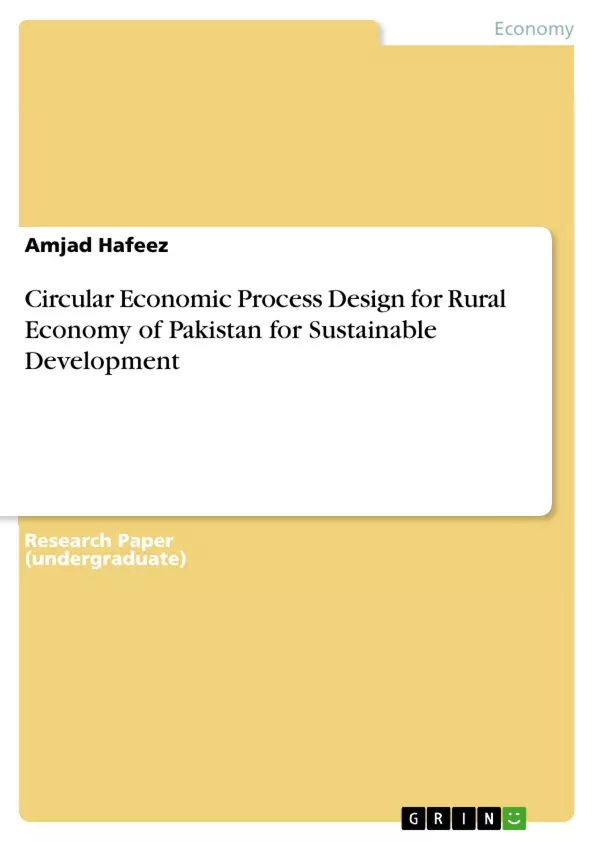Earth has finite resources. The demand for resources is increasing with population increase and resultant economic growth. The generic process of Take-Make-Dispose is putting great stress on earth’s finite resources. As Demand increases, economic system takes raw materials from natural world, converts it into some value added product, supplies it to the consumers and consumers dispose it off with the end of its lifetime or replacement with new updated version of that product. Apart from this product conversion, we are consuming resources for our food and this demand for food is growing exponentially. The time is nearing when this will deplete resources and we will have to search for new worlds to feed human population on earth. But there is another solution to this problem. That is replication of natural food chain in economic and technological systems. This is called circular economy or cradle to cradle approach. For millions of years, biological nutrients were being returned to earth to enrich it. Industrial processes have given rise to technological nutrient which is input for techno-sphere for reuse. To this system there is no waste. This is called cradle to cradle. This is to integrate various components of economic system and industrial processes in a way that a waste output of one industry becomes input for the second interconnected industry in the form of a cycle. This is also called waste to food phenomenon which gives rise to circular economy. But this transition to a circular economy, where the value of resources is preserved in the techno-sphere, must be supported by policies and operational decision-making based on evidence.
Pakistan is one of the top producers of milk in the world with total annual production of over 42 million tonnes. This milk production is from farmers with individual buffalo and cow herds. This milk and dairy output contribute 11% to the national GDP. These animals also provide meat and raw leather for the industrial sectors. These animals generate waste in the form of dung and urine. This waste is used for fuel purpose at rural homes and used as manure for crops. Before using, it is left to decompose in the open which generates methane and other green-house gases along-with unpleasant and unhealthy odour.
Inhaltsverzeichnis (Table of Contents)
- INTRODUCTION:
- METHOD:
- CURRENT PRACTICES IN VILLAGE ECONOMY:
- IMPLICATIONS OF WASTE GENERATED FROM THREE SYSTEMS OF RURAL ECONOMY IN PAKISTAN.
- ECONOMIC IMPACT:
- POTENTIAL ECONOMIC LOSS FROM FOUR MAJOR CROPS:
- POTENTIAL ECONOMIC LOSS FROM ANIMAL WASTE:
- FINANCIAL SUBSIDY TO ELECTRICITY AND GAS CONSUMERS:
- ENVIRONMENTAL IMPACT:
- DEFORESTATION:
- GREEN HOUSE GASES EMISSIONS:
- WASTE WATER:
- SOCIAL IMPACT
- ENERGY POVERTY:
- GIRL ILLITERACY:
- SUSTAINABLE WASTE RESOURCE UTILIZATION TO CREATE PROPSERITY AND ACHIEVING SDGS: ..
- CIRCULAR ECONOMY THROUGH 'WASTE TO FOOD':
- Establishment of Animal Waste and Crop Residue Collection Mechanism: ..
- Establishment of Biogas Plants:
- Establishment of microgrid:..
- Wastewater Treatment Plants: .
- Treated Water and Waste Slurry from Biogas plants:..
- Conclusion: .
- The economic impact of waste generation in rural areas
- The environmental impact of waste disposal and its contribution to pollution
- The social impact of waste on issues like energy poverty and girl illiteracy
- The potential of a circular economy model to create prosperity and achieve Sustainable Development Goals (SDGs)
- Designing sustainable economic processes by linking different sectors through circular economy principles
Zielsetzung und Themenschwerpunkte (Objectives and Key Themes)
This article aims to explore the potential of a circular economy model for sustainable development in the rural economy of Pakistan. It focuses on analyzing the waste generated by different systems in rural areas, particularly animal waste, crop residue, and wastewater, and how these wastes can be transformed into valuable resources through a 'waste to food' approach.
Zusammenfassung der Kapitel (Chapter Summaries)
The paper begins with an introduction outlining the global challenges of resource depletion and the need for a shift towards a circular economy model. It then analyzes the current practices in the rural economy of Pakistan, particularly focusing on the waste generated from animal husbandry, crop production, and household activities. The article further delves into the economic, environmental, and social implications of this waste generation. It examines the potential economic losses arising from inefficient waste management and the contribution of waste disposal to environmental degradation, including deforestation, greenhouse gas emissions, and water pollution. The social impact of waste, particularly on energy poverty and girl illiteracy, is also explored.
The paper then presents a detailed analysis of how a circular economy model can be implemented in rural Pakistan to achieve sustainable development goals. It proposes a 'waste to food' approach to transform animal waste, crop residue, and wastewater into valuable resources. The chapter discusses the establishment of animal waste and crop residue collection mechanisms, biogas plants, microgrids, wastewater treatment plants, and the utilization of treated water and waste slurry from biogas plants. It also explores the potential of this approach for generating clean fuel, electricity, and additional income, while simultaneously minimizing environmental degradation and promoting social well-being.
Schlüsselwörter (Keywords)
Circular economy, waste management, rural economy, Pakistan, sustainable development, 'waste to food', biogas, microgrid, wastewater treatment, Sustainable Development Goals (SDGs), animal waste, crop residue, energy poverty, girl illiteracy.
- Arbeit zitieren
- Amjad Hafeez (Autor:in), 2018, Circular Economic Process Design for Rural Economy of Pakistan for Sustainable Development, München, GRIN Verlag, https://www.grin.com/document/462664



